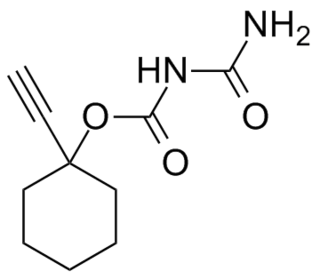
Methyl isocyanate (MIC) is an organic compound with the molecular formula CH3NCO. Synonyms are isocyanatomethane, methyl carbylamine and MIC. Methyl isocyanate is an intermediate chemical in the production of carbamate pesticides (such as carbaryl, carbofuran, methomyl, and aldicarb). It has also been used in the production of rubbers and adhesives. As a highly toxic and irritating material, it is extremely hazardous to human health. It was the principal toxicant involved in the Bhopal disaster, which killed 3,787 people initially and officially 19,787 people in total.

Aniracetam, also known as N-anisoyl-2-pyrrolidinone, is a racetam which is sold in Europe as a prescription drug. It is not approved by the Food and Drug Administration for use in the United States.

Acetyl chloride (CH3COCl) is an acid chloride derived from acetic acid. It belongs to the class of organic compounds called acyl halides. It is a colorless, corrosive, volatile liquid.

Hair spray is a common cosmetic hairstyling product that is sprayed onto hair to protect against humidity and wind. Hair sprays typically consist of several components for the hair as well as a propellant.
Guar hydroxypropyltrimonium chloride is an organic compound that is a water-soluble quaternary ammonium derivative of guar gum. It gives conditioning properties to shampoos and after-shampoo hair care products. The effects of the cationic charge density, guar concentration in aqueous solution, and treatment time on bleached European hair have been studied. A mechanical testing method has been successfully applied to determine the efficacy of cationic guars to improve the ease of combing. The results were confirmed in a shampoo formulation on both virgin and bleached hair.

Trichlormethiazide is a diuretic with properties similar to those of hydrochlorothiazide. It is usually administered for the treatment of oedema and hypertension. In veterinary medicine, trichlormethiazide can be combined with dexamethasone to be used on horses with mild swelling of distal limbs and general bruising.

Diglycolic acid is an aliphatic dicarboxylic acid, its acidity is between the one of acetic acid and oxalic acid. It is formed in the oxidation of diethylene glycol in the body and can lead to severe complications with fatal outcome.

Cromakalim (INN) is a potassium channel-opening vasodilator. The active isomer is levcromakalim. It acts on ATP-sensitive potassium channels and so causes membrane hyperpolarization. It can be used to treat hypertension as it will relax vascular smooth muscle to lower blood pressure. Hyperpolarisation of smooth muscle cell membranes pulls their membrane potential away from the threshold, so making it more difficult to excite them and thereby cause relaxation.

Trifluoroacetic anhydride (TFAA) is the acid anhydride of trifluoroacetic acid. It is the perfluorinated derivative of acetic anhydride. Like many acid anhydrides, it may be used to introduce the corresponding trifluoroacetyl group. The corresponding acyl chloride, trifluoroacetyl chloride, is a gas, making it inconvenient to work with. Trifluoroacetic anhydride is the recommended desiccant for trifluoroacetic acid.

Lithium tetrachloroaluminate (LAC, lithium aluminium chloride) is an inorganic compound, a tetrachloroaluminate of lithium, with the formula LiAlCl4.

Emamectin is the 4”-deoxy-4”-methylamino derivative of abamectin, a 16-membered macrocyclic lactone produced by the fermentation of the soil actinomycete Streptomyces avermitilis. It is generally prepared as the salt with benzoic acid, emamectin benzoate, which is a white or faintly yellow powder. Emamectin is widely used in the US and Canada as an insecticide because of its chloride channel activation properties.

Laurolactam is an organic compound from the group of macrocyclic lactams. Laurolactam is mainly used as a monomer in engineering plastics, such as nylon-12 and copolyamides.
Silver perrhenate is a chemical compound with the formula AgReO4. This compound is isostructural with the mineral scheelite (CaWO4). Silver perrhenate reacts with trimethylsilyl chloride to give the silyl "ester" (CH3)3SiOReO3.

Clocental (dolcental) is a carbamate-derived sedative hypnotic. It can be prepared by the ethynylation of cyclohexanone followed by reaction with allophanyl chloride.

Dimethylcarbamoyl chloride (DMCC) is a reagent for transferring a dimethylcarbamoyl group to alcoholic or phenolic hydroxyl groups forming dimethyl carbamates, usually having pharmacological or pesticidal activities. Because of its high toxicity and its carcinogenic properties shown in animal experiments and presumably also in humans, dimethylcarbamoyl chloride can only be used under stringent safety precautions.

N,N,N′,N′-Tetramethylformamidinium chloride is the simplest representative of quaternary formamidinium cations of the general formula [R2N−CH=NR2]+ with a chloride as a counterion in which all hydrogen atoms of the protonated formamidine [HC(=NH2)NH2]+ are replaced by methyl groups.

2-Methylene glutaronitrile is a dimerization product of acrylonitrile and a starting material for di- and triamines, for the biocide 2-bromo-2-(bromomethyl)pentanedinitrile and for heterocycles, such as 3-cyanopyridine.

Taurates (or taurides) are a group of mild anionic surfactants. They are composed of a hydrophilic head group, consisting of N-methyltaurine (2-methylaminoethanesulfonic acid) and a lipophilic residue, consisting of a long-chain carboxylic acid (fatty acid), both linked via an amide bond. The fatty acids used could be lauric (C12), myristic (C14), palmitic (C16) or stearic acid (C18), but mainly mixtures of oleic acid (C18:1) and coconut fatty acid (C8 – C18) are used. Besides sodium, no other counterions play a relevant role (these could be e. g. ammonium or other alkali or alkaline earth metals).
Dimethylaminoethyl acrylate or DMAEA is an unsaturated carboxylic acid ester having a tertiary amino group. It is a colorless to yellowish, water-miscible liquid with a pungent, amine-like odor. DMAEA is an important acrylic monomer that gives basic properties to copolymers.






















